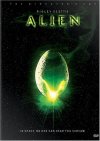BUY THE DVD:
|


|
|
|
SYNOPSIS:
| |
a mining ship, investigating an sos, lands on a distant planet. the crew discovers some strange creatures and investigates.
|
|
|
MOVIE FACT:
| |
in an early draft of the script the "ripley" character was male.
|
|
|
RATING:
|




four out of four possible stars
|
|
|
|
In 1979, Alien put director Ridley Scott on the map. And now, in 2003, he's convinced Twentieth Century Fox, the copyright holder on his film, to re-release his "director's cut" theatrically, allowing an entirely new generation of movie-goers to experience the film on the big screen. It's not uncommon for a director to revisit his work in the years beyond when his or her movie is released into theaters, but those revised works are usually seen as special edition video (or DVD) releases, not big screen roll-outs.
And though Alien is not going to be haunting every single Cineplex in the land, seeing this film on a screen that makes Ripley's nemesis a staggering twenty feet tall is breathtaking. With the soundtrack and print scrubbed clean in a computer, the look of the film is flawless and even the primitive feeling computer screens and controls can't detract from what is probably one of the scariest films ever made. Why even insert "probably" into that sentence. Alien is by far the most bone-chilling film ever made, for a variety of reasons.
The team responsible for creating the look of the alien, led by the designer, Hansruedi Giger (who also created the alien in Species), must have peered into the deepest, darkest nightmares they'd ever had to invent such a monster. Just seeing the ooze drip off one of the many shiny surfaces of the alien is enough to give anybody a chronic case of the willies. What is truly amazing about the creature is that it still inspires cold-hearted fear over two decades after it was originally put on the screen. For a film dependent on its special effects, it's quite a feat that the film has stood the test of time, given the heavy computer graphics driven films of today.
The production design of the film is also an unforgettable morass of organic curves, leaden pipes, and ooze-coated floors. Michael Seymour, who headed the production design team (aided by the uncredited Roger Christian and Anton Furst), surely created one of the most memorable space vehicles ever put on screen via the U-shaped ship that houses the alien eggs the crew finds near the beginning of the film. And straddling the bridge between the violin-based orchestral sound of the soundtracks of the 1960's and 1970's and the brassy, heavy sounds of today's movie tunes, score composer Jerry Goldsmith was already thirty years into his career when he participated in this film. The music, beautiful like a symphony yet composed with the idea of creating cinematic tension and horror, is immediately recognizable yet different from anything currently being put on the big screen.
With each of these production elements hitting the screen with such excellence, one would assume the actors would have an easy job hitting their marks and walking through the film. But each of the cast members (there are only eight, including the actor who suited up in the alien costume) makes a memorable impression on the audience with an individuality and spirit missing from most science fiction and horror films today. Far from the cookie-cutter characters present in the innocuous teen-skewing horror films of today (Urban Legend, the Jason films, etc.), Alien has characters with humor, strength, weakness, and anger, and none of the characters displays just one emotion.
Anchored by a complex performance by Sigourney Weaver, seeing the crew members fall one by one is both heart-breaking and exciting. Through subtle relationships that are created early on in the film, the plot is actually driven by character decisions rather than by standard horror or science fiction film techniques. Working with improvisation, some of the dialogue was created by the actors, and this technique benefits the realism of the characters' relationships and the decisions they make throughout the film.
Jumping on the bandwagon of Alien film aficionados will be an especially easy task after seeing this film in a theater, as science fiction films tend to fare better on a big screen, given the usual elaborate production design and special effects. Though viewing the movie on a television with the lights turned off is nearly as engrossing. Almost twenty-five years after it first hit the screen, Alien is still a highly exciting and amazing film. Both methodical in its presentation and beautiful in its design, the film is a success on every level, with cinematography, editing, performance, script, production design, music, and every other element more than coming up to scratch. This film is a modern classic and should hold the test of time for yet another twenty-five years.
Review by Kelsey Wyatt.
| |
|